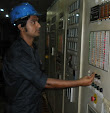In power plants a constant and reliable supply with water in the required qualities is particularly crucial. The process of electricity generation from fossil fuels such as coal, oil and natural gas is Water-intensive. Between 40-50% of all water abstracted and used in developed countries is used in the generation of electricity.
Raw water for use within a HFO power plant may be obtained from a variety of sources, where available in sufficient volumes. Surface waters are most commonly utilised. Freshwater supplies from lakes and rivers are generally considered, although in some instances high salinity waters including seawater are used. Groundwater supplies are typically used in areas where there are insufficient quantities of surface water available of the required quality. The power plants water supplies may also be used for certain applications, eg in make-up water treatment plant. Power plants supplies generally originate from either surface water or groundwater sources or a combination of both. Such supplies typically have received some degree of pretreatment, which may include clarification, filtration and chlorination. Coastal-based power plant tend to use estuarine or seawater as the principal source for cooling water, with other process water requirements met typically from municipal supplies. Some generating plant, using various water treatment processes, utilize high salinity waters from estuaries or the sea to meet all the plant process water requirements.
Components Used in RO Process
- Pumps
- Iron Remover Tank
- RO Water Tank
- Sand Filter
- Carbon Filter
- Micron Filter
- Membrane Filter
- Misled Filter
- Ultra Pure Filter
- Hydra fore Tank
- Expansion Tank
- Delivery Line
Process Flow Diagram
VIEW SYSTEM COMPONENTS PHOTOS
Description of Major Processes
Clarification:
 |
| Iron removal tank |
Conventionally, the clarification process involves coagulation, flocculation and sedimentation reactions. In coagulation, a primary inorganic coagulant, such as aluminium and ferric salts, is dosed to destabilise the suspended particles enabling them to coalesce to form small floc. Flocculation results in the formation of larger and heavier particles from the small particles formed during coagulation, which facilitates their removal by sedimentation. Polyelectrolytes are often used as flocculant aids to promote the aggregation and binding of particles, leading to more rapid settling. There are a number of factors that can affect the coagulation/flocculation process. The most important of these is pH where, for a given coagulant, there is usually an optimum pH at which coagulation/flocculation is most effective.
The most common clarification systems used in power plant applications are those based on sludge blanket clarifiers, solids contact clarifiers or inclined plate clarifiers. Dependent upon the design, the floc either settles as a sludge at the bottom of the clarifier or forms a suspended sludge blanket layer, in which the tendency of the blanket layer to fall is counteracted by the upflow of water. A variety of clarifier designs are available for both pretreatment clarification and wastewater treatment applications. An alternative approach is to inject the coagulant upstream of granular filters with enough residence time in the pipework to allow floc formation. The floc formed is then collected on the filters. This process is known as in-line coagulation. Flocculant aids can also be fed in a similar manner to improve filtration efficiency and increase filter operational service cycles.
Filtration
 |
| Micron filter |
Granular filters, also referred to as deep bed filters, are available in two basic designs: gravity or pressure filtration. In gravity filtration, water flows through the filter medium contained in an open tank or vessel under the influence of gravity. In pressure filtration, the filter medium is held in enclosed pressure vessels and the water is pumped through the filter medium under pressure. Gravity filters produce better quality water compared to pressure filters but their space requirements/footprint are much more than that required for pressure filters of the same capacity. Pressure filters tend to be the preferred choice for power plant applications. Standard media used in deep bed granular systems include anthracite, coarse silica or quartz sand, fine sand and high-density garnet. Filters can be employed with a single medium (typically sand), a dual medium (sand and anthracite) or multi-media (sand, anthracite and garnet). Multi-media filters are generally graded and layered with granule size decreasing and density increasing from top to bottom. This allows the entire depth of the filter to be used to remove solids, rather than just the top surface, as often occurs during the operation of single medium filters.
Microfiltration
 |
| Membrane filter |
Microfiltration removes virtually all suspended solids and some colloidal matter. Worldwide, the application of polymeric membrane microfiltration is widespread in many industrial sectors, but there has been limited experience with this technique within the power sector until recently. Ceramic membrane microfiltration systems are also available but their use is limited relative to the polymeric membrane systems. The hollow fibre has established itself as thebest configuration for membrane microfiltration because its self-supported, back-washable structure is ideal for building compact, large surface area modules. A further development in microfiltration membrane technology has been the use of immersed hollow fibre membranes as opposed to the use of hollow fibre and spiral wound configurations in pressurised vessels or shells.












